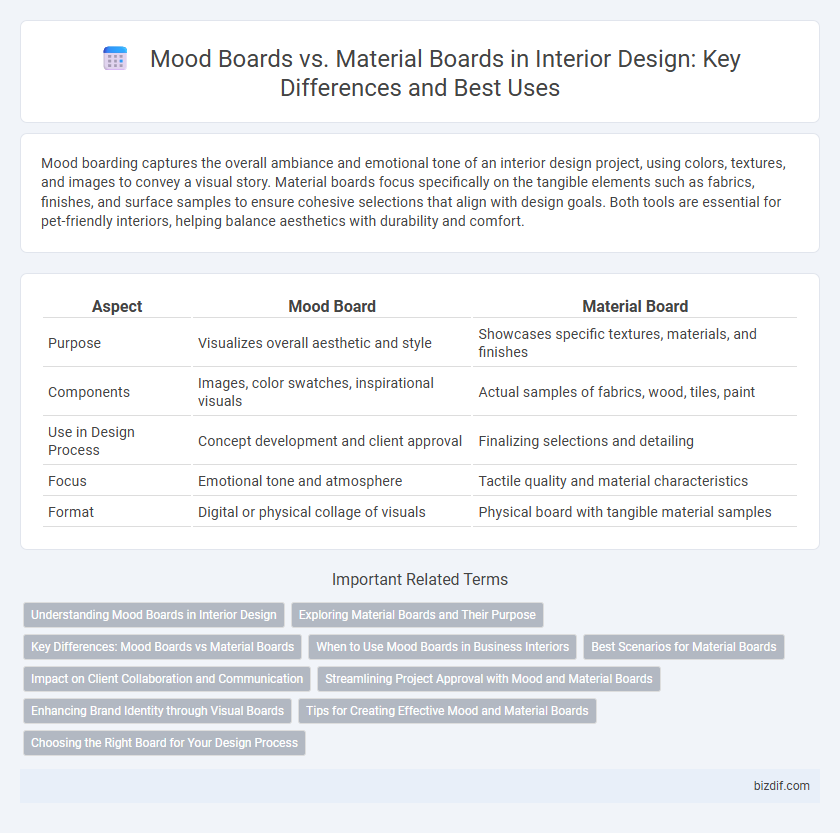Mood boarding captures the overall ambiance and emotional tone of an interior design project, using colors, textures, and images to convey a visual story. Material boards focus specifically on the tangible elements such as fabrics, finishes, and surface samples to ensure cohesive selections that align with design goals. Both tools are essential for pet-friendly interiors, helping balance aesthetics with durability and comfort.
Table of Comparison
| Aspect | Mood Board | Material Board |
|---|---|---|
| Purpose | Visualizes overall aesthetic and style | Showcases specific textures, materials, and finishes |
| Components | Images, color swatches, inspirational visuals | Actual samples of fabrics, wood, tiles, paint |
| Use in Design Process | Concept development and client approval | Finalizing selections and detailing |
| Focus | Emotional tone and atmosphere | Tactile quality and material characteristics |
| Format | Digital or physical collage of visuals | Physical board with tangible material samples |
Understanding Mood Boards in Interior Design
Mood boards in interior design serve as visual tools that capture the overall aesthetic, color palette, and emotional tone of a project, helping designers and clients align their vision early in the process. They typically include images, textures, typography, and inspirational elements that convey mood and style, rather than specific construction details. Understanding mood boards allows interior designers to effectively communicate abstract concepts and set a cohesive direction before selecting precise materials or finishes on a material board.
Exploring Material Boards and Their Purpose
Material boards serve as a tactile and visual tool in interior design, showcasing samples of fabrics, finishes, and textures to ensure cohesive material selection and accurate client visualization. They help interior designers assess the compatibility and interplay of different surfaces, supporting informed decisions about color schemes and tactile experiences. Exploring material boards allows professionals to refine design concepts and communicate material intent effectively throughout the project lifecycle.
Key Differences: Mood Boards vs Material Boards
Mood boards emphasize colors, textures, and overall ambiance to convey the desired emotional tone and style of an interior space. Material boards focus specifically on tangible surfaces like fabrics, flooring, and finishes, providing a tactile representation of the actual materials to be used in the design. The key difference lies in mood boards capturing the aesthetic vision, while material boards offer precise details about physical elements and their coordination.
When to Use Mood Boards in Business Interiors
Mood boards are essential in business interiors when establishing a cohesive design concept by visually representing color schemes, textures, and overall atmosphere to align client expectations and brand identity. They facilitate early-stage creativity and communication, allowing designers and stakeholders to explore emotional responses and aesthetic directions before finalizing material choices. Mood boards help streamline decision-making and set the tone for subsequent material board development, ensuring the interior environment supports productivity and corporate culture.
Best Scenarios for Material Boards
Material boards excel in scenarios where tactile feedback and physical texture are crucial, such as selecting fabrics, finishes, and surface materials for a design project. They provide a hands-on experience that helps clients and designers assess color accuracy, material quality, and compatibility in real environments. Material boards are particularly effective in finalizing design decisions for furniture upholstery, flooring options, and wall treatments where precise texture and durability play key roles.
Impact on Client Collaboration and Communication
Mood boards enhance client collaboration by visually conveying design concepts through imagery, color palettes, and styles, facilitating intuitive feedback and emotional connection. Material boards improve communication by providing tangible samples of textures, fabrics, and finishes, allowing clients to assess quality and compatibility, which reduces misunderstandings and revisions. Combining mood and material boards creates a comprehensive dialogue, increasing client confidence and streamlining the decision-making process.
Streamlining Project Approval with Mood and Material Boards
Mood boards and material boards streamline project approval by visually communicating design concepts and tangible textures to clients, ensuring clarity and alignment early in the process. Mood boards highlight color schemes, ambiance, and style direction, while material boards provide samples of fabrics, finishes, and surfaces that define the tactile experience. Using both boards reduces misunderstandings and accelerates decision-making, resulting in more efficient and confident project approvals.
Enhancing Brand Identity through Visual Boards
Mood boarding captures a brand's emotional tone and visual style by combining colors, textures, and imagery to evoke the desired atmosphere. Material boards showcase tangible samples like fabric swatches, finishes, and surfaces, providing a concrete representation of the design elements. Integrating both mood and material boards strengthens brand identity by aligning sensory experiences with visual narratives, ensuring cohesive and immersive interior design presentations.
Tips for Creating Effective Mood and Material Boards
Use high-quality images and textures that represent the desired color palette, style, and ambiance to create cohesive mood boards that clearly communicate the design vision. Material boards should include physical samples such as fabric swatches, wood finishes, and paint chips to provide a tactile reference for clients and contractors, ensuring accurate material selection. Organize both boards logically with labeled sections and maintain a balance between variety and simplicity to enhance clarity and decision-making throughout the design process.
Choosing the Right Board for Your Design Process
Mood boards capture the visual essence and emotional tone of a design through images, colors, and textures, helping to articulate the conceptual direction early in the process. Material boards emphasize physical samples like fabric swatches, finishes, and hardware, providing a tactile reference for selecting materials that ensure cohesion and functionality. Selecting the right board depends on whether the project phase demands emotional storytelling or practical material decision-making to streamline design development.
Mood boarding vs Material boards Infographic

 bizdif.com
bizdif.com